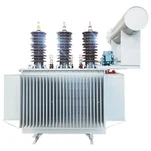The final drying process of transformers is critical to ensure that all moisture is removed from the insulation materials, which helps enhance the dielectric strength and overall performance of the transformer. Here are the common methods of drying employed during the final drying process:
1. Vacuum Drying
a. Process Overview
Mechanism: Involves placing the transformer in a vacuum chamber where air pressure is reduced. This lowers the boiling point of water, allowing moisture to evaporate at lower temperatures.
Temperature Control: The temperature can be carefully controlled to prevent damage to insulation materials.
b. Benefits
Efficient Moisture Removal: Rapidly removes moisture from insulation materials.
Preventing Oxidation: Reduces the risk of oxidation during the drying process.
2. Forced Air Drying
a. Process Overview
Mechanism: High-velocity warm air is circulated through the transformer to evaporate moisture. This method is often used in conjunction with heaters to increase air temperature.
Airflow Management: Proper airflow ensures that moisture is effectively removed from all parts of the transformer.
b. Benefits
Speed: This method can dry the transformer quickly, depending on the airflow and temperature.
Simplicity: Easier to set up compared to vacuum drying systems.
3. Oven Drying
a. Process Overview
Mechanism: The transformer is placed in a heated oven for a specified period. The heat helps to evaporate any moisture trapped in the insulation.
Controlled Environment: The drying environment can be controlled to maintain a consistent temperature.
b. Benefits
Thorough Drying: Ensures that all moisture is eliminated.
Uniform Heat Distribution: Provides even drying across the transformer.
4. Infrared (IR) Drying
a. Process Overview
Mechanism: Infrared heaters emit radiation that heats the surface of the transformer, causing moisture to evaporate quickly.
Targeted Heating: This method can be directed at specific areas where moisture is likely to accumulate.
b. Benefits
Rapid Drying: Can speed up the drying process significantly.
Localized Treatment: Effective for areas that may retain moisture longer.
5. Hybrid Drying Systems
a. Combination Methods
Process Overview: Some manufacturers may employ a combination of methods, such as vacuum drying followed by forced air drying, to optimize the drying process.
Customizable: The drying protocol can be tailored based on the specific transformer design and moisture content.
b. Benefits
Efficiency: Maximizes moisture removal while minimizing potential damage to insulation.
Flexibility: Adaptable to various transformer sizes and types.
6. Post-Drying Testing
a. Moisture Content Measurement
Process Overview: After the drying process, moisture content is typically measured using methods such as capacitance testing or using moisture meters.
Quality Assurance: Ensures that the transformer meets the required moisture levels before it is put into service.
b. Dielectric Testing
Purpose: Conducting dielectric strength tests after drying helps verify that the insulation has not been compromised during the drying process.
Conclusion
The final drying process of transformers employs various methods, including vacuum drying, forced air drying, oven drying, infrared drying, and hybrid systems. Each method has its benefits, and the choice may depend on the specific transformer design, the level of moisture present, and operational requirements. Post-drying testing is essential to ensure the effectiveness of the drying process and the overall reliability of the transformer.










